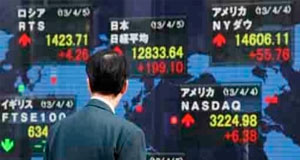 Last week proved to be quite a week for stock markets with the FTSE100 posting its best week since 2011, while the S&P500 also managed to post its best week this year.
Last week proved to be quite a week for stock markets with the FTSE100 posting its best week since 2011, while the S&P500 also managed to post its best week this year.
With US markets closed today for the 4th July Independence Day holiday European markets may well be quieter than usual, though they will be no less driven by the expectations of lower for longer interest rates in light of the events of recent days.
In Asian markets the main focus was on the Australian election which saw Prime Minister Malcom Turnbull’s decision to call an election backfire spectacularly after the vote failed to produce a clear winner as Australia became the latest country to fall victim to dysfunctional politics. With four Prime Ministers in three years the Australian PM had hoped to kick start a new administration, but he reckoned without the same voter dissatisfaction with incumbent politicians that has been a hallmark of elections globally in the last 12 months.
The big risk now is that any delay in forming a new government could well undermine the Australian economy as well as the Australian dollar, at a time when sentiment is already fragile, due to the pre-election wrangling and failure to agree on a budget, which had already been delayed in the preceding weeks.
Back closer to home while Bank of England Governor Mark Carney was quick to reassure markets that the central bank remained ready to act to keep markets stable, and help ease economic and credit conditions it is hard to believe that the decline in the pound as well as UK government bond yields won’t elicit a response from central banks elsewhere around the world.
In all the furore surrounding the Brexit vote it has almost gone unnoticed that the Chinese yuan has seen a decline against the US dollar back to the levels that prompted this year’s early January market freak out, while it seems only a matter of time before Japanese authorities look at measures to try and weaken the yen after seeing some significant gains across the board in recent weeks.
The main focus this week away from Brexit concerns given that the triggering of article 50 seems some way off is likely to be on the latest US economic data towards the end of the week, the latest FOMC minutes and the latest US payrolls report, given the shocker of a report we saw in May.
Before that we also have the latest in a string of UK data starting today with the latest construction PMI numbers for June. On Friday we managed to see a pickup in the manufacturing sector for June as activity jumped from 50.1 to 52.1, though most of this came before the 23rd June Brexit vote, which could mean we could see a negative reaction when the July numbers come out next month.
Expectations for construction PMI are for a decline to 50.6 from 51.2 largely as a result of pre Brexit uncertainty. The recent weakness in this sector in recent months could also account for why investors sold off the house builders so aggressively in the wake of last month’s Brexit vote.
A decent number here could well see some of those concerns recede, however we may have to wait a few months to see what longer term effect recent events have had on the sector.
EURUSD – despite a move to 1.1155 the euro has slipped back as it oscillates directionless around the 200 day MA. This suggests we could get a move either way and keeps the prospect for a move towards the March lows at 1.0825 on the table. To stabilise we need to see a move back above the 1.1250 area.
GBPUSD – slid back sharply away from the 1.3530 dropping back below 1.3400 in the wake of Governor Carney’s comments yesterday. We need to hold above the 1.3120 level or risk a move towards 1.2800. To stabilise and mitigate the risk of a move below 1.3000 towards 1.2800 we need to see a move back through the 1.3650 area.
EURGBP – having managed to move above the 0.8370 area, the 50% retracement of the move from the 2008 highs at 0.9802 to the 2015 lows at 0.6934, we could well head towards the 0.8706 area. This is the 61.8% retracement area of the same move. We need to hold above the 0.8200 area for this to unfold.
USDJPY – while below the 103.50 area the risk remains for a return to the 100 level as well as the previous lows at 98.95. A move below 100.00 is likely to prompt the risk of further losses and possible BoJ intervention concerns.













